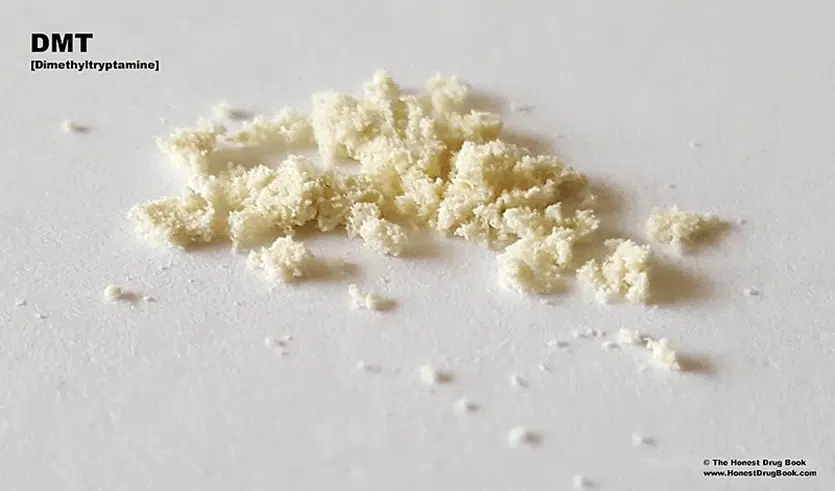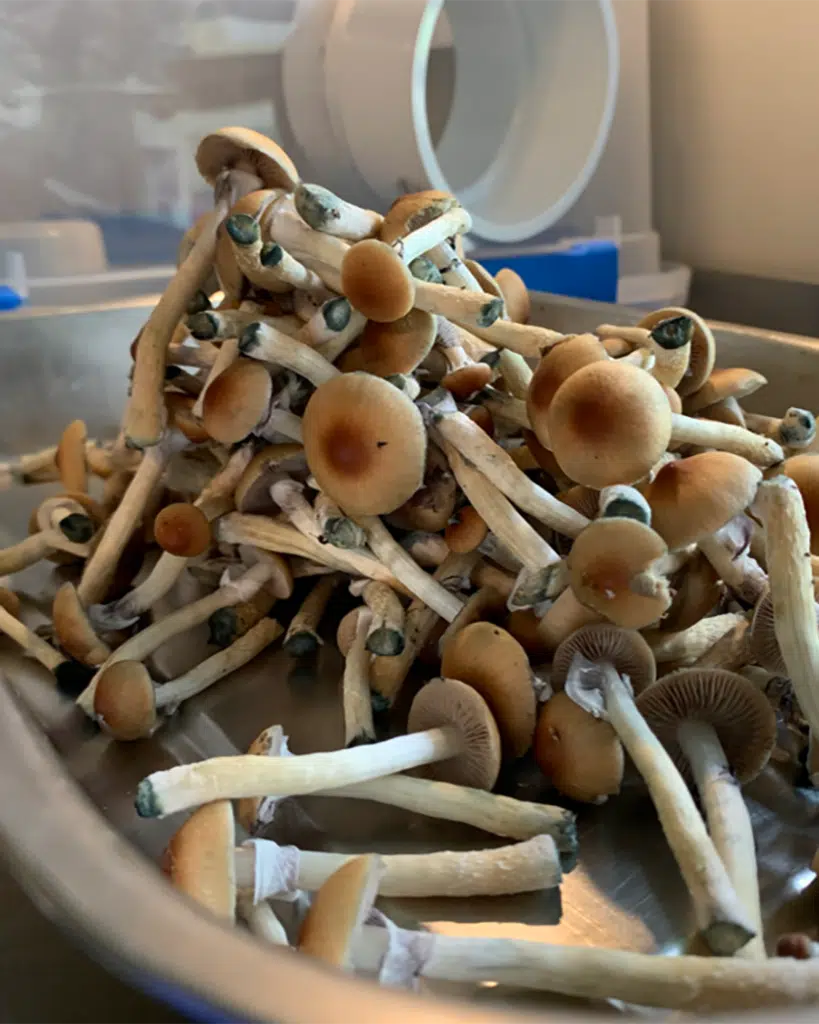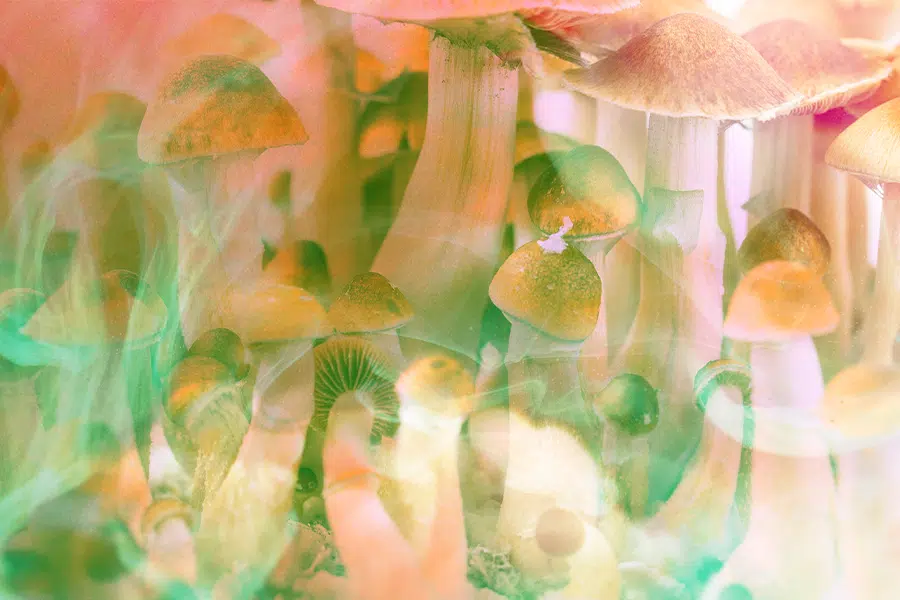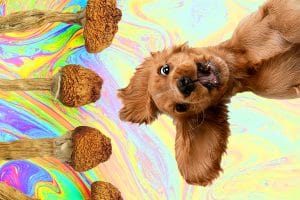DMT and magic mushrooms are among the most well-known and popular entheogens amongst psychonauts. And while both naturally occurring psychedelics may get lumped together in the same category, there is quite a bit of difference between DMT and mushrooms. Wondering how each stacks up in the debate over DMT vs. mushrooms? This is your guide.
The Differences Between DMT and Mushrooms
Mushrooms are, well, mushrooms. We’d be surprised if you’re entirely unfamiliar with these many-shaped fungi just as easily found lining supermarket shelves as they are growing from the soil along your favorite nature trails. There are over 14,000 known species of mushrooms, and they can be found in every inhabitable continent on the planet. Mushrooms are everywhere. And chances are, even if you’re not an experienced psychonaut, you’re at least aware of magic mushrooms.
Magic mushrooms are a special subset of around 200 mushroom species that harbor a potent psychedelic compound called psilocybin. Humans’ relationship with psilocybin mushrooms extends back some 12,000 years or more, far longer than we’ve been living in civilizations. Indigenous cultures from Mesoamericans to early Siberians used mushrooms in shamanistic practices and medicine.
While some awareness of psilocybin mushrooms is commonplace, knowledge of DMT is perhaps less so. While both DMT and psilocybin mushrooms are naturally occurring psychedelics, that’s about where the similarities end.
DMT (or N, N-Dimethyltryptamine), however, is the name of a distinct psychedelic compound found in a number of different Amazonian plants. DMT is perhaps most famously found in ayahuasca. Ayahuasca is a traditional brew used in shamanistic rituals for over a thousand years in a number of South American cultures.
Unlike mushrooms, DMT’s relationship with humans is more recent and far more localized. It’s only been within the past hundred years or so that DMT-containing plants have really been accessible to folks outside of the Amazon—although there are many plant species around the world that contain DMT.
How to Grow Shrooms Bundle
Take Both of Our Courses and Save $90!
DMT vs. Psilocybin
As chemical species, DMT and psilocybin are actually fairly similar. Both molecules belong to a class of compounds called tryptamines. The tryptamine class includes natural neurotransmitters like serotonin, as well as many psychedelic substances found in plants and fungi. Yet, there’s one important way that the two compounds differ: Their metabolism.
It isn’t actually psilocybin that produces psychoactive effects in the brain. Instead, the fungal compound is converted into the more active chemical species psilocin by the human liver. It’s psilocin that travels through the bloodstream and makes it into the brain. Both DMT and psilocin share a similar molecular structure—if you’re wondering exactly how similar, psilocin is also known as “4-hydroxy DMT” to chemists. Of course, little differences have a big impact in the world of chemistry.

Pharmacologically, DMT and psilocin also share similarities. Yet, it’s important to keep in mind that we still have a lot to learn about their mechanisms of action. Like most psychedelic chemicals, DMT and psilocin both interact with the brain’s serotonin receptors. You probably know serotonin as the neurotransmitter that lifts and stabilizes mood. Engagement with the serotonin-receptor may influence the euphoric feeling you get after consuming psychedelics like DMT or mushrooms.
Yet, although both psychedelics are most commonly associated with serotonin, their actions extend beyond the neurotransmitter. Both compounds may influence levels of oxytocin, for example, which is a hormone and neurotransmitter associated with social bonding and maternal behavior. Oxytocin is often called the “love hormone” due to its role in inspiring feelings of warmth and connection. Serotonin receptors may play a role in oxytocin regulation.
However, you can always have too much of a good thing, and serotonin is no expectation. When your serotonin levels are too high your mood can start to swing the other way. Loss of muscle coordination, confusion, and agitation are all symptoms of excess serotonin. In severe circumstances, excess serotonin can contribute to potentially life-threatening serotonin syndrome.
The DMT vs. Mushrooms Trip
A trip on either DMT or mushrooms is liable to be a profound, introspective journey tinged with visual hallucinations. But, beyond this, the DMT and mushroom experiences are quite different. Your trip will deviate in intensity and duration based on which of these entheogens you choose to take. What you’re looking to get out of your trip will help inform whether you should take DMT or mushrooms. Looking for an all-day experience? Then you might be keen on shrooms. Low on time, but seeking a profound experience? Then DMT might be the ticket.
Let’s break down the difference between tripping on DMT and mushrooms.

Duration
The length of your trip is substantially different if you’re taking mushrooms or consuming DMT.
Going on a mushroom trip is something of an all-day affair. After consumption, the mushrooms can take up to an hour to kick in, and from there you can expect a trip that lasts an average of four to six hours. While the amount of mushrooms you choose to take won’t impact the length of your trip, how you choose to take them will. Consumption methods like Lemon Tekking often give you a shorter, more intense mushroom trip.
On the other hand, tripping on DMT is a much shorter event. When inhaled, DMT comes on in a matter of minutes and the whole trip lasts only about half an hour. Consuming DMT via changa will cut your trip down to about fifteen minutes, but creates a longer state of euphoria once you come down.
Drinking ayahuasca is another beast entirely. Traditional ayahuasca ceremonies can last several days, and the trip itself can be an intense four to six hours. However, actually accessing one of these ceremonies is tricky and expensive. As such, most people who do not have access to ceremonies partake in inhaled DMT.
Trip
A DMT trip is short and quite often profound. There’s a reason why one of DMT’s nicknames is “The Spirit Molecule.” Psychonauts regularly report experiencing a sense of oneness with the world around them, sightings of mystical entities, and in some cases ego death.
These profound experiences are typically accompanied by audio-visual hallucinations. Under the right circumstances, you may journey to what DMT trippers refer to as other “realms.” These realms are spaces outside of normal human existence where you will communicate with DMT entities and are likely to have the most potent DMT experience.

Mushroom trips, while typically much longer than DMT trips, don’t tend to come with the same kind of intensity. Although this isn’t something to take lightly—most consumers still find the mushroom experience to be profound, intense, and sometimes otherworldly. A mushroom trip can still prompt deep reflection and forced interrogation of emotions and experiences, especially when larger amounts of mushrooms are consumed.
These emotional trips are less common on lower doses, where you are more likely to experience moderate perspective shifts. Sometimes referred to as “museum doses,” low-dose mushroom trips offer a slight shift in perspective and often an elevated mood.
Full hallucinations—which are indistinguishable from reality—are rare with mushrooms, although possible with very high doses. More often than not, however, you are liable to see the world around you breathe, sway, dance, and shift in sometimes ridiculous ways. Auditory hallucinations aren’t common either, though listening to a favorite record on mushrooms can yield a whole new experience and interpretation of the music.
Side Effects
Bad trips happen. When we talk about the side effects of consuming things like DMT and psilocybin mushrooms, we’re mostly discussing the less-than-desirable aspects of these psychedelics. As with other aspects of DMT and mushrooms, many of these potential side effects are similar. The deeply introspective nature of DMT and mushrooms can sometimes lead you to confront emotions such as shame and grief. And while many folks find their trip to be helpful in overcoming these emotions or finding closure to unresolved issues, your emotions can also become uncomfortable, frightening, and overwhelming.
Moving from the psychological to the physical, both DMT and mushrooms can make you feel disoriented, lacking in muscle coordination, and generate headaches and nausea. Mushrooms in particular are difficult for your body to digest, and nausea or stomach discomfort (sometimes referred to as shroom stomach) is common.
How to Grow Shrooms Bundle
Take Both of Our Courses and Save $90!
In most cases, however, a bad trip can be avoided. Ensuring you have the right set and setting is key to keeping you in the best possible emotional state during your DMT or mushroom trip, and consumption methods like mushroom tea help prevent nausea and physical discomfort.
And of course, it’s always worth mentioning: Psychedelics are not for everyone. As with any mind-altering and unregulated substance, there are always risks. Many psychedelics are contraindicated with cardiovascular problems and psychosis. They may not mix well with some medications, and there’s always the potential of accidentally consuming an unexpected substance. As such, it’s always important to do due diligence when partaking in mushrooms, DMT, or any other substance.
DMT vs. Mushrooms Legality
The legality of both psilocybin mushrooms and DMT in the United States is complicated. Strictly speaking, the psychedelic compounds psilocybin and N, N-Dimethyltryptamine are classified as Schedule 1 drugs under the Controlled Substances Act. This means that the federal government believes both psilocybin and DMT are at high risk of abuse with no medicinal applications—even if this isn’t the case for either substance. This means that even if the specific mushroom or DMT-containing plant you have isn’t explicitly prohibited, you can still get in trouble because of the chemicals that reside within them.
Things are changing, however. Oregon became the first state to decriminalize all drugs back in 2020, and activists there continue to push for further policy reforms. And individual cities like Denver and Oakland have passed similar resolutions, making owning and consuming both mushrooms and DMT pretty safe in those jurisdictions, at least from a legal perspective.
And with that, you should have everything you need to get yourself started with DMT and magic mushrooms. Both of these entheogens will give you a deeply personal and profound psychedelic experience. Whether you want to sip a shroom tea, and gently drift through the day, or you’d prefer a quick ride to another realm with inhaled DMT this guide should help you get on your way.
Interested in having a psychedelic experience, but don't know where to start? Get our definitive guide on trusted legal retreat centers, clinical trials, therapists, and more.
We started DoubleBlind two years ago at a time when even the largest magazines and media companies were cutting staff and going out of business. At the time we made a commitment: we will never have a paywall, we will never rely on advertisers we don’t believe in to fund our reporting, and we will always be accessible via email and social media to support people for free on their journeys with plant medicines.
To help us do this, if you feel called and can afford it, we ask you to consider becoming a monthly member and supporting our work. In exchange, you'll receive a subscription to our print magazine, monthly calls with leading psychedelic experts, access to our psychedelic community, and much more.


